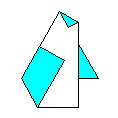| Origami Heaven A paperfolding paradise The website of writer and paperfolding designer David Mitchell
|
|||||||||||||
|
|||||||||||||
 |
|||||||||||||
| There
are two ways to do this. By exploring the possibilities
the paper offers you as you fold or by learning technical
design skills. Exploratory paperfolding designers sit down and play with the paper and see what emerges. They may have some basic idea of what they would like to see happen, and some idea of the basic structure of the folds that will be used but they will not have a detailed plan of how to get from A to B or a rigid idea of what the final result will look like. This sounds a bit crazy ... but it works, if you have the right kind of mind. I am an exploratory paperfolding designer of this kind. One way to learn to do this is to begin with a traditional paperfold and see what happens if you vary a few folds here and there. Are there other ways to lock the folds together (there are), are there other things the paper could become? Probably. Another is to start with one of the standard bases such as the bird base or the waterbomb base and see what possibilities it offers you. My favourite method, however, is to start with a blank piece of paper and a blank mind and try to find out what the paper wants to become. You need a good deal of imagination for this. Can you see the potential for an original design in a few simple folds? Can you see how to develop those folds to reach the final result? Technical designers on the other hand proceed in an entirely different way. They begin by knowing what it is they want to design, a horse, a wheelbarrow, a Black Forest Cuckoo Clock, whatever, and apply their knowledge of folding techniques to work out how to get to the result they want. Working in this way requires a good deal of technical knowledge and you can only get that by studying existing designs and understanding how those designs are constructed. There are mathematical tools that can help with this. If you want to pursue this course then the book Origami Design Secrets by Robert Lang is probably the place to start. Both strategies have weaknesses and strengths. Exploratory designers have to learn to live with the fact that they may often come up with designs that are new to them but already well known to other people. This can be embarrassing if you rush in and announce your great new discovery to the world. Caution is a better approach. Rediscovering the wheel is something you get used to though - and you have the benefit of the enjoyment of the learning process. It happens to all of us from time to time. Exploratory paperfolding design does however still produce wonderfully fresh ideas and designs of astonishing originality that make you ask why nobody has thought of that before. Technical paperfolding design is good at producing awe inspiring results. If you want to make a dragon covered with thousands of individually crafted scales you can probably learn how to do so. On the other hand many designs produced in this way are rather sterile and uninteresting. They may gain you kudos with your fellow technical designers and people who know nothing about origami but are they elegant to fold? Will they stand the test of time? Will they become instant classics in the way that the best exploratory designs do? |
|||||||||||||